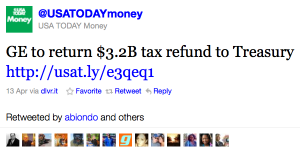Last Wednesday, USA Today editor Doug Stanglin reported about the Associated Press’s hugely embarrassing misfire-of-a-story on General Electric. In a blog post headlined “AP falls for prank report that GE is giving back a $3.2B tax refund,” Stanglin quoted from AP’s correction, included the full text of the retracted AP story on GE, and cited a report from Reuters about the activists behind the hoax.
 It was a thorough rundown except for one thing: USA Today had also fallen for the prank report. The fact that it ran the bogus story from AP, and later removed it from USAToday.com, did not make it into Stanglin’s blog post. Why not?
It was a thorough rundown except for one thing: USA Today had also fallen for the prank report. The fact that it ran the bogus story from AP, and later removed it from USAToday.com, did not make it into Stanglin’s blog post. Why not?
Many news outlets run wire stories using an automated feed of some kind. Given the speed and volume of the content it’s easy to see how mistakes or problems could be missed — and whether news sites should be responsible for corrections to erroneous wire stories they’ve run has been an open question, as we noted in this recent error report.
But when a news outlet makes the effort to report on another outlet’s high-profile bungle — and fails to mention its own participation — readers are bound to wonder why.
If you searched for the bogus GE tax story on Google News on Wednesday, you would have seen that USA Today ran with it:
Or, if you were one of USA Today Money’s more than 200,000 followers on Twitter, you might’ve seen it there (or via one of the many people who retweeted it):
Many people quickly took notice of USA Today’s publication of the story, including the pranksters themselves. But later on Wednesday if you clicked on the link to that story, you arrived on a USA Today page simply telling you that it had been removed:
In other words, between the link to the retracted story (later on filled in with AP’s correction) and Stanglin’s blog post, USA Today essentially provided no record on its site that it played a part in spreading some majorly wrong “news.” Nor was there any mention on USA Today’s corrections page, despite the high-profile nature of the mistake, which had real consequences. (GE’s stock price dropped significantly on the fake news.)
If the AP’s blunder had been headed for USA Today’s print pages, it would have been caught and not published — but even in the unlikely event that it had been published, you can be sure the paper would have run a correction notice in a subsequent edition. Online publishing makes it easier to cause embarrassing errors to disappear, but it doesn’t remove any of a publisher’s responsibility to own up to and correct them.
MediaBugs reached out by email to both Stanglin and standards editor Brent Jones to find out why USA Today handled things the way they did. Both responded quickly and cordially, with a definitive explanation on Friday morning from Jones:
USA TODAY’s newsroom practice is to be forthright and transparent when setting the record straight. We responded to reader inquiries and published a correction on Twitter, but we should have included that we published the AP’s story when reporting on the GE tax hoax. To clarify with our readers, website editors have since updated our blog posting, posted a note on our corrections/clarifications blog and the AP’s corrected report.
It’s good that USA Today had put the word out on Twitter, and we applaud them for addressing the problem thoroughly on their site pages in response to our inquiry. (You can now see those updates here, here, and here.) Also worth noting is that USA Today’s accessibility and corrections practices put them at the front of the pack of U.S. media. Even so, in this case they needed external prodding to do the right thing.
Perhaps the online medium makes it easier to stumble in this way. It’s simple enough to unpublish something and just move on — and far too many news sites still lack a clear process for tracking and rectifying their mistakes. There may also be an increasing tendency, navigating today’s ephemeral sea of news, to shrug off responsibility for nonproprietary content. Wire stories, blog posts and tweets seem at once to come from everywhere and nowhere. That’s precisely why this case is instructive.
It’s simply not possible to walk away from the kind of goof USA Today indirectly made. Social media, search engines and other tools will capture it. As more and more content is syndicated, aggregated or borrowed (with or without permission), newsrooms may feel they are less responsible for its accuracy. But in an era of deep distrust of the media, the opposite has to be true. When a news site chooses to repeat someone else’s report it shoulders new accountability along with it — including a duty to correct errors, thoroughly and forthrightly, before they get compounded further.



 Report an error
Report an error